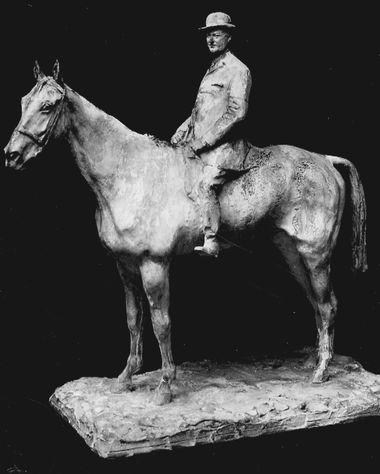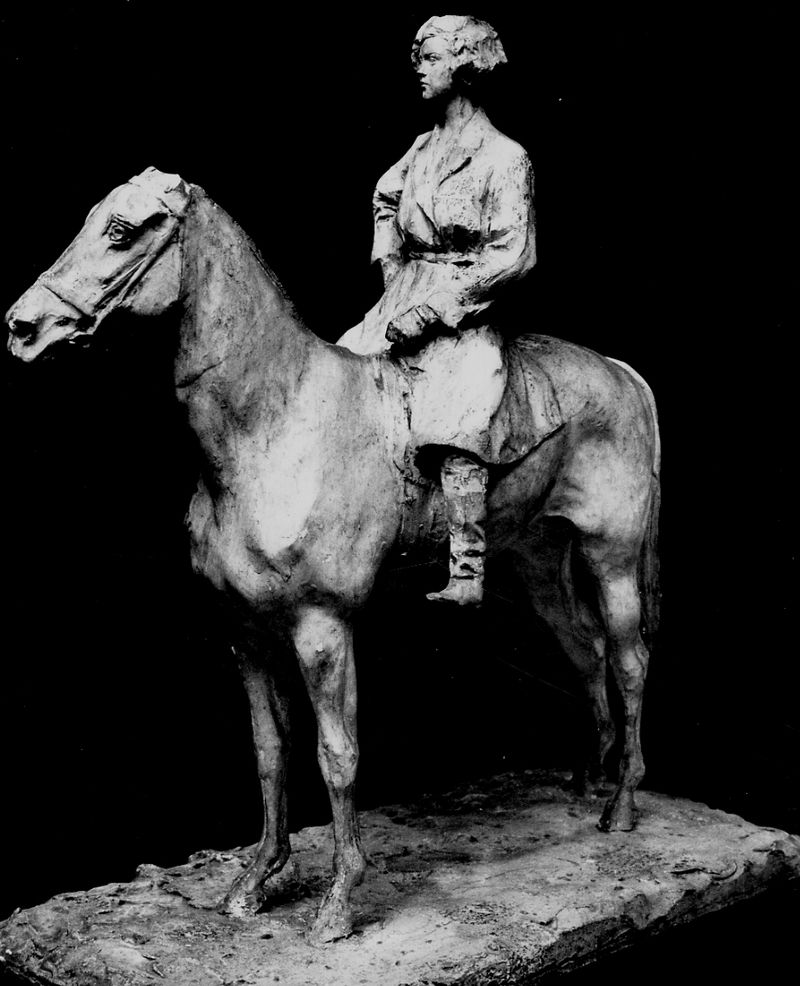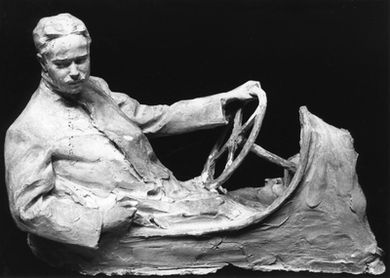Paul Troubetzkoy - members of the Bugatti family sculpted

Paul Troubetzkoy was one of the friends of the Bugatti family, especially of Carlo. Famous sculptor, he is one of the first to recognize the talent of Rembrandt Bugatti.
Troubetzkoy was a Russian / Italian prince, born in Northern Italy, son of a Russian Diplomat and an American Opera singer. He moved in all society and artist circles throughout Europe, and even the USA. Many of the famous people of the time were scuplted by him, including various members of the Bugatti family. He died in 1938.
Not too long ago in September 2019 one of these sculptures, of Ettore Bugatti on horseback (Top and Right), was sold for an impressive amount to a Bugatti collector (with an estimate of CHF 8,000 - 12,000, it was sold for CHF 128 400). However, there is more, with many of the Bugatti family having been sculpted.


The horse, standing on all fours, turns its muzzle slightly to the left. The rider, of mature age, sits erect, hands lowered on the saddle, in the act of holding the reins. He wears a riding suit: boots, wide trousers, long jacket buttoned in front; on his head he wears a round bowler hat. His face is round and hairless. The base is rectangular. There is a large eroded area on the horse's back.
The character portrayed is traditionally identified with Ettore Bugatti, The physiognomy corresponds to that of period photographs, which depict the well-known car manufacturer, sometimes together with one of his thoroughbreds. A portrait of Ettore Bugatti on horseback, executed by Troubetzkoy in 1929, is reported in a recent publication (Cat. Mostra "I Bugatti", Turin, 1988, p. 71). J. Grioni (J. Grioni, Scheda "La Vittoria", p. 109, in Cat. Exhibition "Musei del Piemonte", Turin, 1981) reports that in 1929 Troubetzkoy went to the Bugatti car factory in Molsheim (Alsace) . The dating of the work to 1929 is therefore plausible. In the Museum there are other portraits of members of the Bugatti family.
 The man, of mature age, is standing, his left foot advanced, his hands in his pockets. He wears an open jacket over a buttoned waistcoat, a high-collared shirt with turned-up ends, a bow tie. His face, with a round outline, is adorned with a mustache and beard.
The man, of mature age, is standing, his left foot advanced, his hands in his pockets. He wears an open jacket over a buttoned waistcoat, a high-collared shirt with turned-up ends, a bow tie. His face, with a round outline, is adorned with a mustache and beard.
The work, due to its stylistic characteristics and the style of clothing, can be placed in the sculptor's youthful production. The physiognomy of the character depicted appears very similar to that of Carlo Bugatti, of whom a work by Troubetzkoy in 1899, with dedication, is reported (see cat. Mostra Bugatti, 1988). If the information is correct, it would therefore be a work performed during a visit to Milan by the sculptor, who was residing in Russia at the time. Inventories: GT, 1977, no. T 130. Restoration carried out in 1976 by the sculptor G. Taverna of Turin: "the head was reattached and placed on the base because the feet and part of the legs were missing" (see Q. A. Taverna, n. 124). Bibliography: Bossaglia, Bernabò, Giubilei, Cat. Exhibition "I Bugatti", Turin, 1988, p. 71. For an updated bibliography see: "Paolo Troubetzkoy 1866-1938" edited by G. Piantoni and P. Venturoli, exhibition catalogue, Turin, 1990
 The man, of youthful age, has his hands behind his back, intertwined under the flap of his open jacket. The waistcoat is buttoned over a shirt, closed at the neck by a straight tie; his trousers have turn-ups at the bottom and folds in the front. The expression on his face, long and thin, is serious; his build is tall and thin.
The man, of youthful age, has his hands behind his back, intertwined under the flap of his open jacket. The waistcoat is buttoned over a shirt, closed at the neck by a straight tie; his trousers have turn-ups at the bottom and folds in the front. The expression on his face, long and thin, is serious; his build is tall and thin.
The angular features and slender figure of the young man robably depict the physiognomy of the animalist sculptor Rembrandt Bugatti, whom Troubetzkoy met in Milan and continued to frequent in Paris. The portrait could date from the time of his stay in that city (1905-1914), also on the basis of the age of the subject. In other portraits executed by Troubetzkoy in different periods, members of the Bugatti family are recognized. Inventories: GT, 1977, no. T 38. Restoration carried out in 1976 by the sculptor G. Taverna of Turin: "reinforced base, with figure support" (see Q. A. Taverna, n. 36). For an updated bibliography see: "Paolo Troubetzkoy 1866-1938" edited by G. Piantoni and P. Venturoli, exhibition catalogue, Turin, 1990.
Troubetzkoy also sculpted a small group of elephants, which may have been created during Troubetzkoy's stay in Paris, where he saw and frequented his pupil Rembrandt Bugatti.

The horse is standing on all 4 legs, in a static pose. The young woman sits erect, her right hand on her side, her left on the pommel of the saddle. She wears boots, a knee-length coat cinched at the waist with a belt. Her short, wavy hair is parted to the side.
In the first inventory of the Museum (1912-82) the work is indicated as a portrait of Lidia Bugatti. It is probable that the portrait was executed together with those of her father Ettore and of Friderich, on the occasion of Troubetzkoy's visit to the automobile factory in Molsheim, in 1929. Inventories: GT, 1977, n. T 104; MP"A", 1919-82, no. 510. Restoration carried out in 1976 by the sculptor G. Taverna of Turin: "attached horse tail" (see Q. A. Taverna, n. 101). For an updated bibliography see: "Paolo Troubetzkoy 1866-1938" edited by G. Piantoni and P. Venturoli, exhibition catalogue, Turin, 1990
It seems odd that no sculpture is known of Barbara Bugatti; it is most likely that Troubetzkoy would also have sculpted her. This may be the case, Troubetzkoy sculpted a great many ladies, not all of whom have been identified. There are close to a thousand works by Troubetzkoy identified, not impossible that one of them is of Barbara Bugatti, or maybe Carlo's wife Teresa.


Above two sculptures of the same subject, both of a young man, sitting at the wheel of a car, in two different poses. He wears a high-collared jacket, fully buttoned in the front. His face, with a round outline, is adorned with a small moustache.
 The character portrayed, traditionally referred to as "Bugatti", is in the museum catalog falsely identified as being Jean Bugatti. It is much more likely to be Ernest Friderich, at the wheel of a Bugatti Type 13, which he was actively racing at the time, see the photo on the left. The character portrayed, traditionally referred to as "Bugatti", is in the museum catalog falsely identified as being Jean Bugatti. It is much more likely to be Ernest Friderich, at the wheel of a Bugatti Type 13, which he was actively racing at the time, see the photo on the left.
Thus the identification as "Bugatti" is correct, but stands for the car only.
It is therefore also questionable that execution would have taken place during Troubetzkoy's visit to the Bugatti factory in Molsheim in 1929. It seems much more logical that this is of much earlier date, maybe 1911 or 1912.
Obviously sculpting a man at the wheel of an automobile interested Troubetzkoy, as he made two different versions. A life-size variant of the sculpture on the right is kept in the Museum. The sculpture on the left is of smaller dimensions.
Bibliography: - Grioni J.S., Rembrandt Bugatti, un grande animalier, in Antichità viva, Florence, n. 1, 1973.
- Bossaglia / Castagnoli/ Troubetzkoy, P. Troubetzkoy sculptor, Intra, 1988, pp. 101-102
For an updated bibliography see: "Paolo Troubetzkoy 1866-1938" edited by G. Piantoni and P. Venturoli, exhibition catalogue, Turin, 1990
Source of some of the photographs and information: catalogo.beniculturali.it. Search for Troubetzkoy Bugatti.
At the 2023 TEFAF art show there were two of Troubetzkoy's sculptures. One of Giacomo Puccini, the other of Henri de Rothschild.




|


